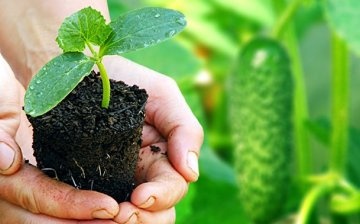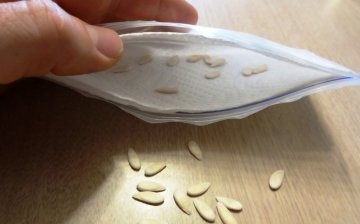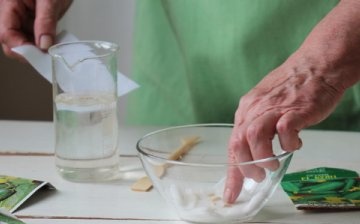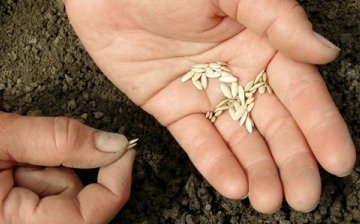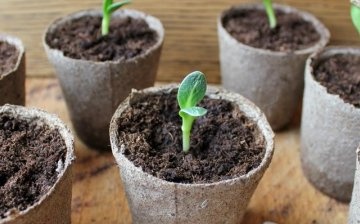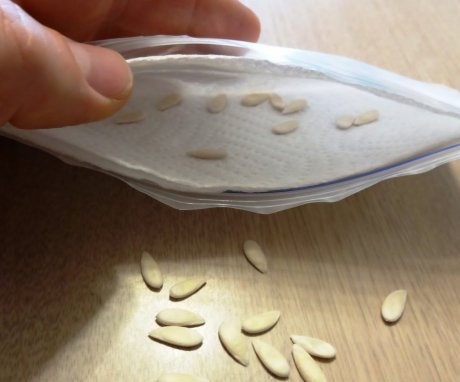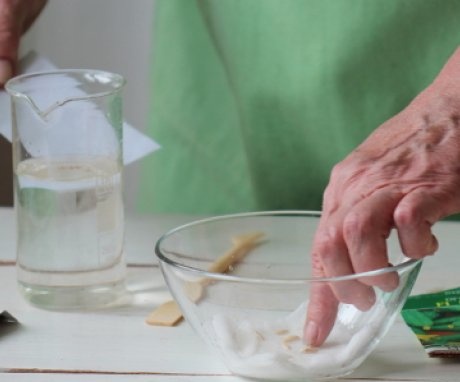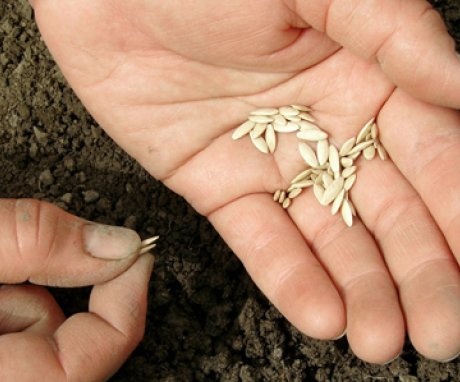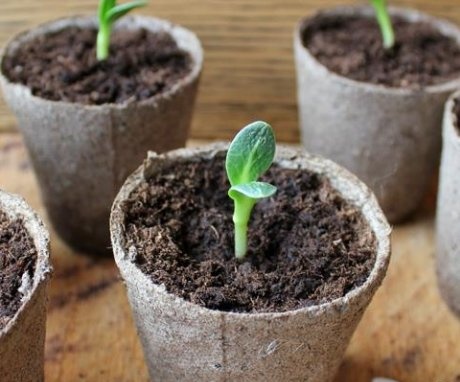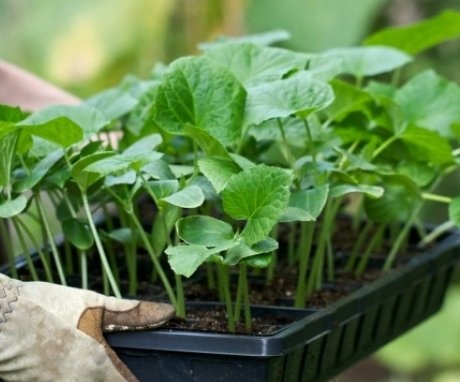Growing seedlings of cucumbers: preparation and methods of planting seeds
Growing seedlings cucumbers has many positive aspects: guaranteed and earlier harvest, long fruiting period, strong, stress-resistant plants. Ultimately, the time and effort spent on growing seedlings in the spring will result in their own savings in the summer.
Content:
Seed preparation
Proper seed preparation is the key to getting good harvest... It is important to know about one feature of cucumbers: seeds of 3-4 years old germinate best of all. But if such seed not available, last year's will do.
When harvesting seed on your own, it is important to remember that F1 hybrid varieties, as a rule, do not fully convey the qualities of the parent variety. It is impossible to predict what kind of crop will grow from such seeds.
There are a number of rules that must be followed in order for your seeds to sprout well and amicably:
- Seeds are sorted (calibrated) and full-weight are selected.
- Warm up.
- Disinfect.
- Germinate.
- The germinated seed material is hardened.
The procedure for selecting full-fledged, high-quality seeds is quite simple: seeds are placed in salt water (2 tablespoons of salt per liter of water). Those that float to the surface are removed, and those that have sunk to the bottom are washed with water, dried and used for planting. When sizing, the seeds are sorted into piles by size. The depth of planting depends on the size of the seed: large ones are deepened into the ground by 1.5 cm, small ones - by 0.8 cm.
To collect a rich harvest, cucumber seeds are heated.
This can be done during the entire winter period by determining the location storage seed material next to the central heating battery (temperature range 23-35 degrees). Or before sowing place the seeds for 3.5 hours in a thermostat or oven at a temperature of 50 degrees.
Disinfection prevents fungal infection of plants diseases... Seeds offered by specialty stores are sold after processing.
Disinfection is dry and wet:
- For wet processing, a 1% solution of potassium permanganate is used, this is the simplest and most environmentally friendly option. The seeds are kept in a warm solution for 30 minutes and then washed with water.
- For dry processing, special preparations are used: TMTD and granosan NIUIF-2. Seeds with powders are placed in a glass jar, buried and shaken for 5 minutes. Since the preparations are poisonous, when working with it, take precautions: you need to wear protective goggles on your eyes, cover your mouth and nose with a gauze bandage.
To increase seed germination, it is recommended to germinate, pretreated with growth stimulants (desirable, but not necessary). One of the following drugs is dissolved in one liter of water:
- Baking soda - 5 g
- Zinc sulfate - 2 g
- Boric acid - 20 mg.
The seeds are kept in any of these solutions for 24 hours at room temperature. Treatment of seeds with growth stimulants contributes to their rapid germination and development of shoots.Germination of seeds consists in keeping them in a damp cloth or gauze at room temperature until they hatch.
The final stage of preparing seeds for sowing is hardening - keeping the seeds (swollen, only hatched) in the refrigerator for 2-3 days. Another way to alternate between cold temperature (in the refrigerator for 5-7 hours) and room temperature (15 hours), the procedure is done 4-5 times. Hardening is very important for outdoor plants. Presowing treatment seeds facilitates seed germination and promotes strong short shoots seedlingsresistant to stress.
Landing dates
To determine when to plant seeds cucumbers, you need to focus on the optimal age seedlings, in which it is planted in open ground. Permanent cucumbers transplanted at the age of 25-30 days. That is, in central Russia, the time of planting seeds is approximately from May 20, in the southern regions - from April 10 to 20.
You need to be guided by the conditions of each spring - early or late - and, depending on this, adjust the planting dates.
If you will be planting seedlings in open ground, it is important that the time of frost has passed by this time. When planting to the greenhouse the planting time can be rescheduled.
Planting methods
Since cucumbers react extremely negatively to pick, the seeds are recommended to be immediately planted in separate containers: these can be containers with soil (plastic or peat) or peat tablets... For planting seeds in containers, you can use disposable cups with a diameter of 10-15 cm:
- Make holes in the bottoms of the cups.
- Lay drainage (you can use small expanded clay or pebbles).
- Add soil.
- Make indentations (depending on the calibration results) 1-2 cm.
- Plant sprouted seeds, one in each cup.
- Sprinkle with soil.
- Drizzle a little.
- Close with foil.
- Put in a warm place (temperature 25 degrees).
After the emergence of seedlings (usually on the third day), the film is removed, and when the cotyledons open, you need to lower the temperature in the room with seedlings to 20 degrees. This will help avoid pulling the plants.
In order for the seedlings to take root well in the open field, it is advisable to plant the seeds in a soil mixture similar in composition to the soil in the beds.
Therefore, when planting seeds in peat tablets with all the advantages and conveniences of this method, consider this feature of cucumbers. There are many options for preparing a soil mixture, and yet the following soil composition will be the most optimal:
- Soil from the garden - 2 parts.
- Peat - 1 part
- Sand - 1 part.
Or:
- Soil from the garden - 3 parts
- Sand - part 1
- Rotten manure - 6 parts.
The soil purchased in the store must be poured out of the bags into some containers a couple of days before planting so that it is saturated with oxygen. Then fill the containers for planting with saturated soil, water a little and put in a warm place to warm up for 2 hours. Do not use plastic containers from fermented milk products for planting, they contain bacteria that have a detrimental effect on cucumber seedlings and are the cause of the disease root system.
A very convenient planting option is in peat pots. The porous walls of the containers allow for good oxygen access to the roots and normal soil moisture. In open ground, seedlings are planted directly in pots, which is absolutely painless for the root system and provides one hundred percent survival rate. A huge advantage of peat tanks is the absence of pathogenic bacteria and good strength in both wet and dry conditions.
Care after landing
Tips for caring for cucumber seedlings:
- An important part of caring for your seedlings is creating sufficient light for your plants. With a lack of light, the sprouts stretch out, the seedlings become thin and weak.If there is not enough light in a room with seedlings, it is necessary to organize additional illumination with fluorescent lamps (40-80 watts), which are located at a distance of about 5 cm from the plants.
- On fine sunny days, the lamps can be turned on only before sunrise and after sunset; in cloudy weather, artificial lighting should work all day. You can use special phytolamps.
- For the normal development of seedlings from the second week, you need to maintain a temperature regime of about 23 degrees, when the temperature rises, ventilate the room and spray plants with water.
- As the seedlings grow, containers (cups) with plants must be moved apart from each other in order to avoid shading with grown leaves.
- Watering carried out with warm, settled water with a temperature of 25 degrees. The soil should be moderately moist: not dry, but not excessively wet either. In the first days, the seedlings of cucumbers are watered often, in the following - moderately. With the appearance of the second real leaf watering increase again.
For the entire period of growth, it is recommended to feed the seedlings 2-3 times mineral fertilizers:
- The first feeding is in the phase of one true leaf.
- The second feeding is in the phase of two true leaves.
- The third feeding - 14 days after the second.
For feeding, a solution is made - for 10 liters of water:
- Ammonium nitrate - 7 g
- Superphosphate - 15 g
- Potassium sulfate - 8 g
- Bird droppings - 200 g.
With the behavior of the second and third feeding, the above dose of fertilizers is doubled. Top dressing with microelements will also be useful, it will help increase the resistance of plants to diseases... A week before planting seedlings in open ground, it is recommended to carry out a hardening procedure: during this week, in a room with seedlings, you need to open the vents, starting from 2 hours a day and gradually bringing this interval to a whole day.
Also, a week before transplanting to the beds, cucumbers need to be accustomed to the sun's rays: expose the seedlings for 1 hour a day in the sun and increase the time spent in the sun up to 3 hours a day.
Such procedures will greatly facilitate the process of adapting seedlings in the open field. Watering at this time is reduced. At the age of one month, in the phase of 3-6 true leaves, the cucumbers are ready for planting in a permanent place. Remember that you can plant seedlings only when the threat of frost has passed.
More information can be found in the video.



